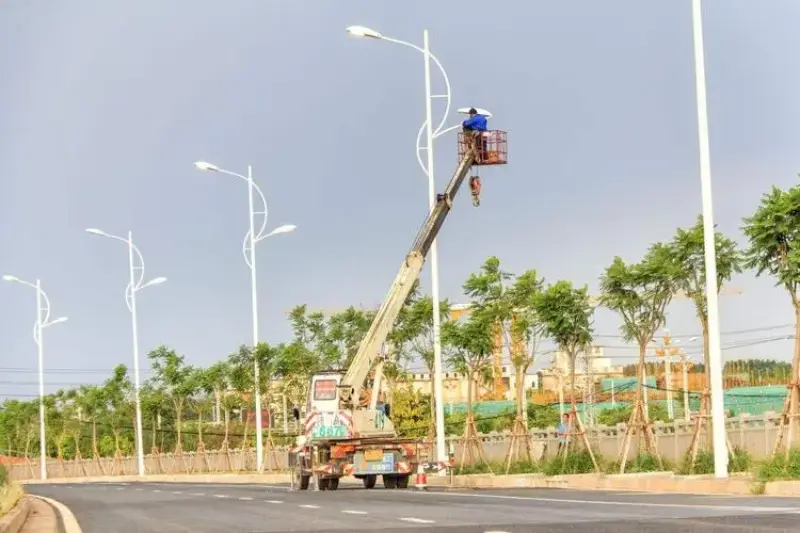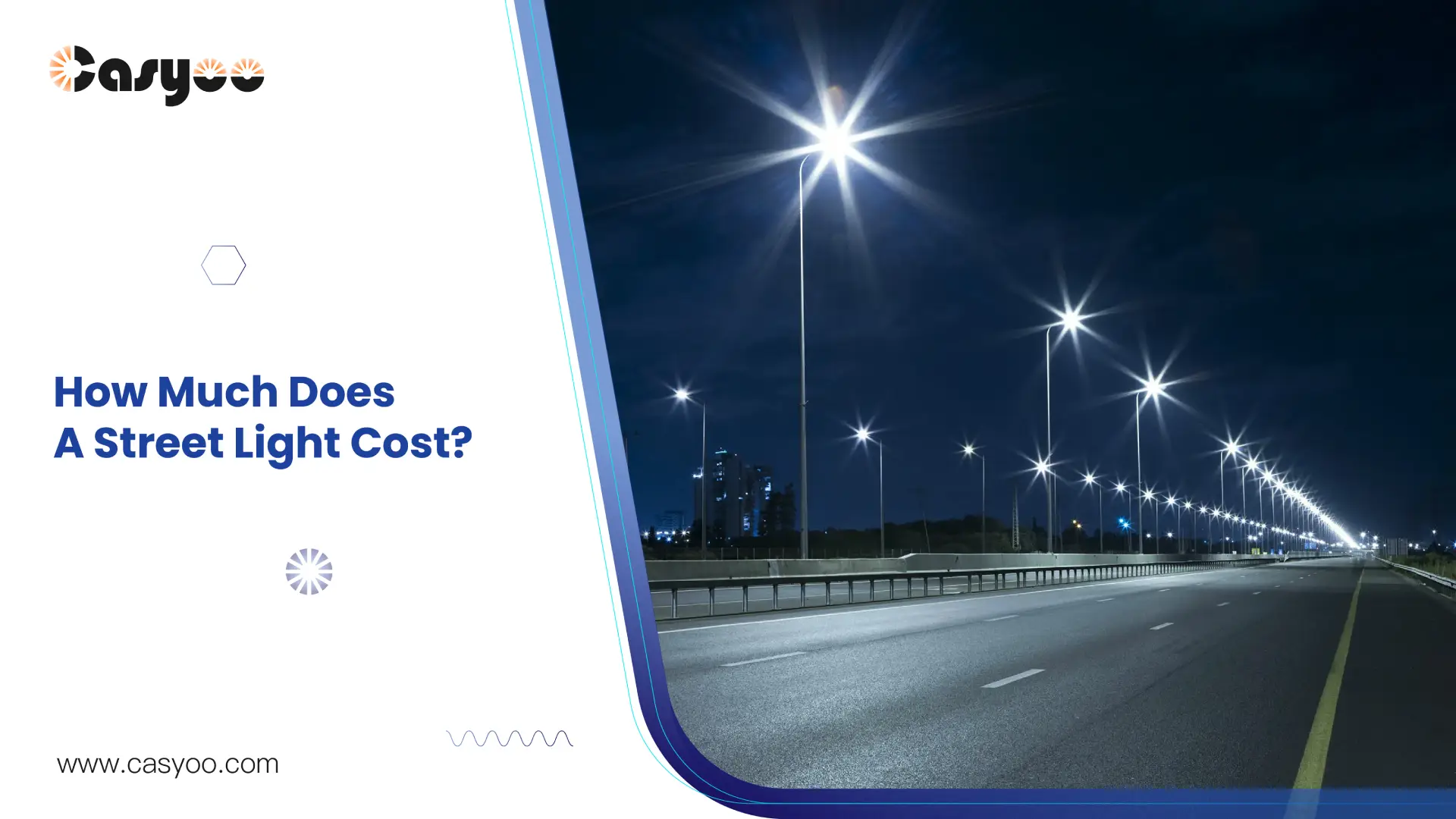Street lights are one of the most common lights in our lives. Are you curious about how much does a street light cost per month? If you are a project manager, you must want to know how much is the total cost of street lights in advance. In this passage, we will count the running cost and other costs of street lights in a clear way. Besides, we will also talk about whether solar street lights and smart street lights can reduce the costs. Let’s dive in!
Installation costs
Lamp installation comes with a number of expenses, such as labor, material, equipment rental, transportation, etc. The length of the road, the height of the street lamp, and other factors all determine the precise expenses. Typically, the entire cost of installation ranges from $1,000 to $4,000.
Material costs
Street lamps have poles of varying materials and heights and can use different light sources. To save as much energy as possible, LED street lights are now used in the majority of countries. The prices also include wires that ensure the regular power supply of street lamps. In addition, auxiliary supplies such as screws, welding rods, cables, and so on are required while installing street lamps. These materials’ pricing varies depending on their specific requirements. The above material cost ranges from $700 to $2,900.
Labor costs
Professionals are recruited to install poles, lights, and wire the lines. The primary steps involved in installing lamp poles are excavation, grouting, and erection. After that, the workers will install the wire pipes, connect wires, and fix lights. This cost, which ranges from $80-300, is determined by the project’s complexity and labor hours.
Equipment rental costs
Excavators are rented for earthworks excavation. The light poles will then be raised using a crane. Other tools, like welding machines and other lighting equipment, are also needed for street light installation. The rental cost of the equipment varies depending on the size of the project and the time it is used. The entire price ranges from $40 to $180.
Other costs
Transporting street light supplies and equipment from suppliers to the construction site incurs considerable transportation costs. Distance, material and equipment weight, and other considerations are taken into account while calculating the cost of transportation. The total costs also include emergency funding, which typically accounts for 5-10% of the project’s total cost. These expenses range from $180 to $700.
Replacement costs
If the project is to replace the original HPS street lights with LED street lights, the costs can be different because of the price of these two light sources. The cost of the other installations is similar. Although LED streetlights are roughly two to three times more expensive than HPS lighting, they require far less maintenance and cost less while operating. We will continue comparing the various expenses of LED and HPS streetlights below.
Running costs
Generally speaking, the municipality is responsible for paying for the running costs of street lights. If it is a private streetlight, the owner needs to pay for the light. To calculate the running costs of streetlights, just use the power of the streetlight * working hours * the price per kWh. We can give an example to compare the running costs of LED and HPS streetlights. Because LED streetlights are extremely efficient, generally a 140W LED street light can replace a 400W HPS streetlight. Assuming that street lights need to work 10 hours a day and the average price per kilowatt-hour is $0.32, the monthly electricity costs of an LED and HPS street light are:
LED: 0.14 kW*10 h*30 d*0.32=$13.44
HPS: 0.4 kW*10 h*30 d*0.32=$38.4
It can be seen that the operating cost of HPS street lights is nearly three times more expensive than that of LED street lights. Use our calculation tool to calculate the running costs of your street lights!
Maintenance costs
The components that need maintenance and inspection include distribution boxes, control systems (controllers and monitoring centers), cables, lamps, lamp poles, etc.
The first thing to pay is the cost of hiring maintenance personnel. The labor cost varies according to factors such as region, working hours, and complexity of the work, and the cost is about $50-150 per hour. When professionals perform maintenance, they may also need to rent equipment such as lifts, which costs about $250-700 per hour.

If there is a problem with the street lights, the components can be repaired, and the maintenance cost needs to be calculated specifically. If it needs to be replaced, the costs will be the price of the components and the installation costs, similar to what we mentioned above.
LED street lights need fewer maintenance costs than HPS lights because they are more stable. They don’t need high voltage to start working and emit little heat. All these features make them more long-lasting and don’t need to be replaced frequently, like the HPS lights.
How much do different types of poles cost?
Common street lamp pole materials include iron, fiberglass, stainless steel, and aluminum alloy. Iron is the most common material for light poles because its performance and price are moderate, about $500-1500 per pole. Fiberglass light poles are very corrosion-resistant but not strong enough, so they are not commonly used. Its price is $1000-2500 per pole. Stainless steel is highly corrosion-resistant and strong, with a lifespan of more than ten years. Its cost is therefore more expensive, at $2000-4000 per pole. Aluminum alloy light poles are more beautiful, lightweight, and suitable for decorative street lights. Its price is about $1500-3000 per pole.
How to reduce the costs of street lights?
- Solar street lights
Solar street lights often need a large initial investment, owing to the fact that they involve various components such as solar panels, batteries, LED lighting, controllers, and light poles. Its price may be 1.5–2 times that of traditional street lights. However, in general, their total costs are lower in the long run. First, when installing, solar street lights do not need to lay cables and install distribution boxes and other equipment like traditional street lights. Just set them up, and the solar street lights can start working. Therefore, you may only need to spend the cost of hiring professionals. Second, solar street lights do not generate electricity bills at all when they are running. After the solar street lights work for several years, the extra money spent on purchasing solar street lights can be offset.
By installing an intelligent street light control system, the brightness of the lights can be automatically controlled. When there is no need for lighting, the smart street lights will turn off. Some smart systems also have fault alarms, which can enable maintenance personnel to solve faults in time. These functions can be achieved by adding a light sensor, pre-programming the system, and applying other new technology.
Conclusion
The cost of street lights mainly includes three parts: installation, operation, and maintenance. Because there are so many affecting factors, the cost of projects may vary. But you can learn which process may incur costs, and then make estimates based on the specific conditions of your region and project. You can also contact Casyoo to get a detailed and accurate quotation exclusive to you!




